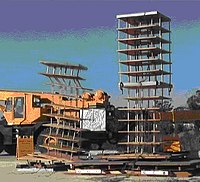
Photo from wikipedia
Over the last two decades, office floors have been built progressively lightweight with increasing spans and slenderness. Therefore, vibration performance of office floors due to walking dynamic loads is becoming… Click to show full abstract
Over the last two decades, office floors have been built progressively lightweight with increasing spans and slenderness. Therefore, vibration performance of office floors due to walking dynamic loads is becoming their governing design criterion, determining their size and shape, and therefore overall weight and embodied energy of the building. To date, floor design guidelines around the world recommend walking load scenarios in offices featuring some or all of the following standard characteristics: (a) walking loads are assumed to be periodic dynamic excitation represented by the Fourier series, including harmonics corresponding to up to the first four integer multiples of the pacing frequency of which at least one is exciting the floor at a resonant frequency and (b) single person walking. However, the literature surveyed provides evidence that such assessment methodology is potentially an over-simplification which does not reflect real walking load scenarios, since crucial features of the floor vibration source, path and receiver are missing. First, in terms of vibration source, realistic scenarios need to feature (a) moving rather than stationary walking forces, (b) stochastic nature of human gait, (c) simultaneous multi-person walking and (d) human–structure interaction. Second, for the transmission path (i.e. office floor structure), two features are needed to consider: (a) realistic office floor layouts and (b) presence, or absence, of non-structural elements. Finally, for the vibration receivers (i.e. floor occupants), (a) vibrations calculated at floor locations occupied by users (instead of at the potential highest response location which may not be occupied), (b) actual period over which occupants feel vibration due to such excitation and (c) assessment of vibration levels based on their probability of occurrence. This study therefore addresses these seldom considered but increasingly important features and discusses realistic approaches to floor design for vibration serviceability.
Journal Title: Advances in Structural Engineering
Year Published: 2019
Link to full text (if available)
Share on Social Media: Sign Up to like & get
recommendations!